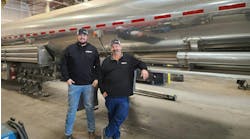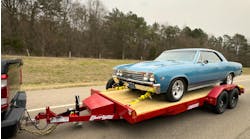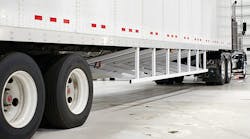The trucking industry and highway safety groups are once again at odds over legislation setting transportation equipment standards. The current debate centers on strengthening underride protection, including additional regulations for rear impact guards and a proposed new side underride guard requirement.
The legislation, “The Stop Underrides Act” (H.R. 1511, S. 665), was reintroduced in March by Reps. Steve Cohen (D-TN) and Mark DeSaulnier (D-CA) in the House, and Sens. Kirsten Gillibrand (D-NY) and Marco Rubio (R-FL) in the Senate. The legislation is a second try at a bill that died in the previous session.
“Congress has the ability to make simple and commonsense changes that would save lives on the roads,” Gillibrand said. “Truck underride guards are one of the best and easiest solutions for protecting passengers and preventing them from being killed when a car collides with a truck.”
The Commercial Vehicle Safety Alliance, an umbrella organization for state and provincial agencies charged with enforcing on-highway trucking regulations, joined the Advocates for Highway and Auto Safety, Truck Safety Coalition, Consumer Reports, and others in supporting the bill.
“If passed, the Stop Underrides Act will help mitigate the severity of underride crashes and make our roadways safer,” said CVSA Executive Director Collin Mooney.
The American Trucking Associations, however, argued that the legislation, “while a well-intended heartfelt response to family tragedy,” is not based on science, data or safety benefit.
“In trucking, we know that one size does not fit all, and that investments in certain technologies that one company makes may not make sense for another,” ATA Vice President of Safety Policy Daniel Horvath wrote in a letter to House and Senate transportation committee leaders. “Standards for new and in-service truck equipment should be based on sound economic and engineering principles that enhance safety, take into account real-world operations, and weigh possible unintended consequences.”
In 2015, 301 of the 1,542 passenger vehicle occupants killed in two-vehicle crashes with a tractor-trailer died when their vehicles struck the side of a tractor-trailer, according to the Insurance Institute for Highway Safety (IIHS). This compares with the 292 people who died when their passenger vehicles struck the rear of a tractor-trailer.
Because of gaps in federal crash data, IIHS researchers couldn’t determine exactly how many of these crashes involve underride, but they estimate that underride occurs in about half of fatal crashes between large trucks and passenger vehicles.
A 2012 IIHS study found that strong side underride guards have the potential to reduce injury risk in about three-fourths of large truck side crashes producing a fatality or serious injury to a passenger vehicle occupant. This proportion increased to almost 90% when restricted to crashes with semitrailers.
Key elements in the Stop Underrides Act include:
- rear underride guard protection for passenger compartments in full-width, 50% overlap, and 30% overlap collisions at 35 miles per hour, with a two-year phase in period for new equipment and a retrofit requirement; and
- side underride guard protection for passenger compartments for collisions at any angle between 10 degrees and 90 degrees at 35 miles per hour, with a two-year phase in period for new equipment and a three-year retrofit requirement.
Truck Trailer Manufacturers Association President Jeff Sims, speaking August 13 at an ACT Research session on the trailer market, noted that most US trailer manufacturers already have developed rear impact guards to meet the 30% overlap requirement. Indeed, according to IIHS, as of September 2018 the top eight trailer manufacturers operating in the US have successfully passed these tests.
Side underride guards are more problematic. Sims explained that, among TTMA’s arguments in challenging the inclusion of trailers under the EPA/NHTSA Phase 2 Greenhouse Gas Emissions and Fuel Efficiency Standards, the additional 200 or so pounds aerodynamic devices add to the weight of a trailer means reduced payload; reduced payload, in turn, means additional truck trips—and more trips entail statistically greater safety risk.
By comparison, the AngelWing side underride protection device from Airflow Deflector Inc.—one tested successfully by IIHS at 40 miles per hour in 2017—comes in at 800 pounds.
“So there’s the weight disadvantage, and there are ground clearance issues when you go into some of these loading docks with steep angles,” Sims said.
He also noted that a German company had to buy back the side underride system it had developed and marketed because of various problems.
“The guard made [the trailer] so rigid that the main beams actually started cracking,” he said. “So they had some catastrophic failures on the road.”
To provide some objectivity, Congress asked the US Government Accountability Office to study the underride issue.
GAO confirmed that “variability in the data collection process” limits NHTSA’s ability to accurately determine the frequency of underride crashes. GAO recommended that NHTSA should provide information to state and local police departments on properly how to identify and record underride crashes, fundamental to any analysis.
Noting the lack of specific requirements that rear guards currently be inspected for defects or damage, GAO also recommended the Federal Motor Carrier Safety Administration should revise Appendix G of its regulations to require rear guards to be examined during commercial vehicle annual inspections.
Finally, noting that designs of crashworthy side underride guards “show promise” at mitigating underride crashes but that manufacturers may be reluctant to move forward without better information on the effectiveness, cost, and implementation standards, GAO recommended NHTSA should conduct additional research to address these questions.
Both ATA and NTEA—The Association for the Work Truck Industry supported the GAO’s call for more study.
In a report to members, NTEA noted that NHTSA has estimated single-unit trucks were involved in only a fraction of crashes compared to tractor-trailers, and that rear underride guards on single-unit trucks were only about 20% effective. During discussions with GAO’s research team, NTEA conservatively estimated first-year costs associated with the legislation at over $200 billion.
The largest portion of these costs would be retrofitting the existing truck and trailer fleet, and the single most expensive requirement would likely be the cost associated with installation of side guards on existing trailers. ATA puts that retrofit cost at almost $35 billion, a “staggering figure” and “likely the largest unfunded mandate on a private sector industry in US history,” said ATA in another letter, this one following a House Transportation subcommittee meeting on “The State of Trucking in America.”
In the June hearing, highway safety groups again called for passage of the Stop Underrides legislation, along with other measures to counter recent increases in truck-related fatalities.
“Most people truly do not understand what is involved in an underride crash until they have suffered the loss of a loved one in one of these crashes or they have seen videos or photos of one of these crashes,” said Andy Young, a truck driver, in his formal statement. “Those families who lose a loved one in an underride crash often suffer even further through a closed casket funeral because the faces of their loved ones are literally obliterated. This is reality and not mere conjecture or rhetoric.”
ATA followed up the hearing with a position paper posted on the blogging platform Medium.
“Pursuing new policies haphazardly—regardless of how noble the intent is—can actually move us further from our common, national goal of zero highway fatalities,” ATA said. In addition to reviewing the GAO conclusions, ATA noted the IIHS tests “have been limited to controlled environments,” and do not reflect real-world speeds and conditions.
Beyond the financial costs, ATA points to the “opportunity costs to safety” the bill would impose.
“Such an expensive mandate would undoubtedly divert the entire $10 billion our industry invests each year away from more promising safety technology and standards, which are backed by sound data,” ATA wrote. “That investment would be taken away from combating the approximately 37,000 annual motor vehicle fatalities—including the 3,400 involving large trucks—and instead appropriate that sum threefold toward reducing the fewer than 300 reported underride fatalities that occur every year.”
The Stop Underrides Act currently has 20 co-sponsors (all Democrats) in the House, and 12 co-sponsors in the Senate, where Rubio is the only Republican to have signed on. No action on the bill is currently scheduled in either chamber.










